Key takeaways:
- IoT in cultivation enhances plant care through real-time monitoring, automation, and data analysis, leading to improved resource management and yield quality.
- Successful integration of IoT technologies, such as sensor networks and automated systems, helps in disease prevention and efficient climate control.
- Despite initial challenges like network connectivity and costs, the long-term benefits, including increased efficiency and sustainable practices, prove valuable for cultivators.
- Personal experiences with IoT highlight its transformative impact on cultivation practices, enabling quick responses to environmental changes and enhancing overall success.
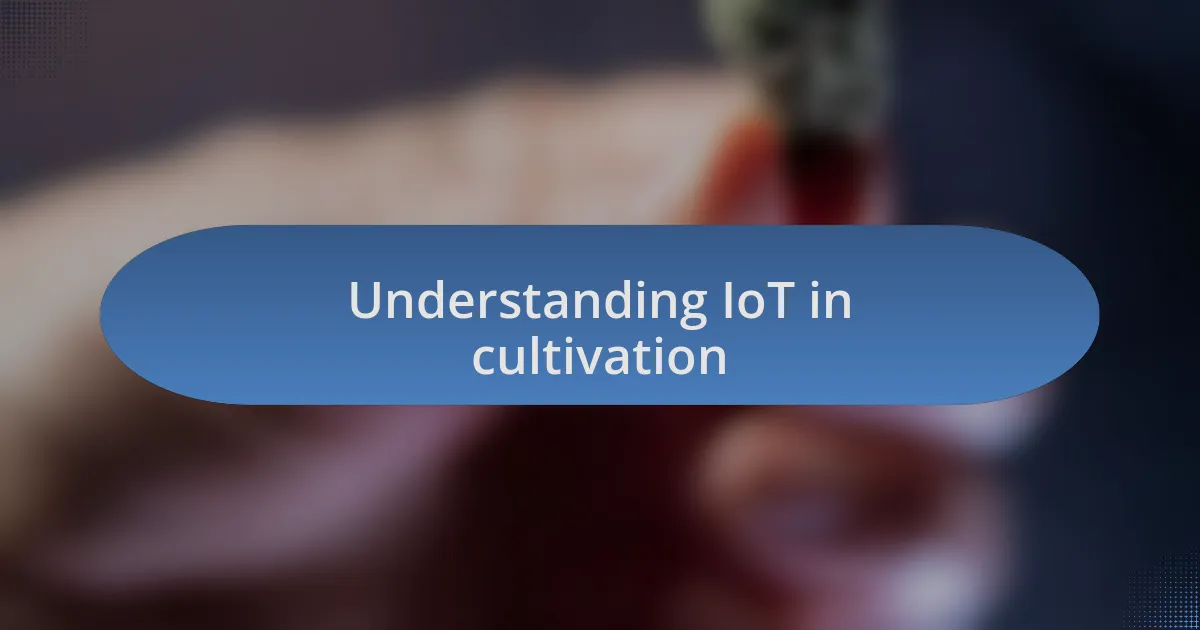
Understanding IoT in cultivation
When I first started exploring the Internet of Things (IoT) for cultivation, I was amazed by its potential to revolutionize the way we grow plants. Imagine sensors embedded in the soil, constantly measuring moisture levels or nutrient availability while sending real-time data to your smartphone. This kind of connectivity not only makes my life easier but also allows for more precise control over the growing environment.
Engaging with IoT technology felt like stepping into the future. The ability to automate tasks, like adjusting light cycles or regulating temperature, opened up a new world of possibilities. Have you ever wondered how much more you could achieve with a little help from technology? For me, it meant freeing up valuable time and resources so I could focus on what really matters—my plants’ health and the quality of my yield.
Understanding IoT doesn’t stop at merely implementing new tools; it’s about fostering a mindset of innovation. For instance, I once encountered a hiccup when my sensors miscalibrated, leading to over-watering my crops. It was a frustrating experience, but it taught me that with the right data analysis, I could continuously improve and adapt my techniques. This interplay between technology and cultivation demands our attention, curiosity, and a willingness to learn from both successes and failures.
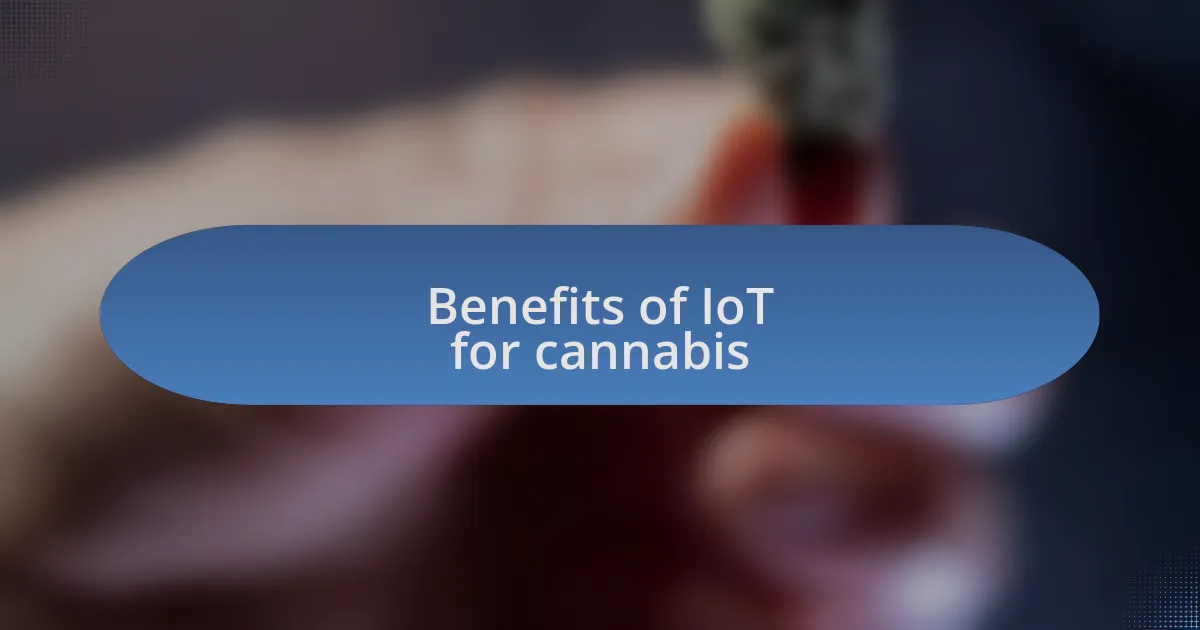
Benefits of IoT for cannabis
The implementation of IoT in cannabis cultivation presents a remarkable advantage in resource management. I remember the first time I checked my smartphone and saw real-time data on light intensity and humidity levels. It was a game changer; I could fine-tune my environment instantaneously without having to physically be there, ultimately saving water and energy.
One of the most significant benefits I’ve experienced is disease prevention. With smart sensors monitoring plant health, I could identify problems like humidity spikes before they spiraled out of control. It made me reflect on the tedious days of guessing and hoping for the best—the peace of mind that IoT brings is invaluable.
Moreover, IoT facilitates data-driven decision-making, which is crucial for optimizing yield quality. Each harvest taught me something new, but with IoT, I can gather and analyze data across multiple grows. It brings a sense of empowerment; I’m not just cultivating blindly anymore. Instead, I’m actively engaging with my environment, adapting my strategies for better outcomes—how cool is that?
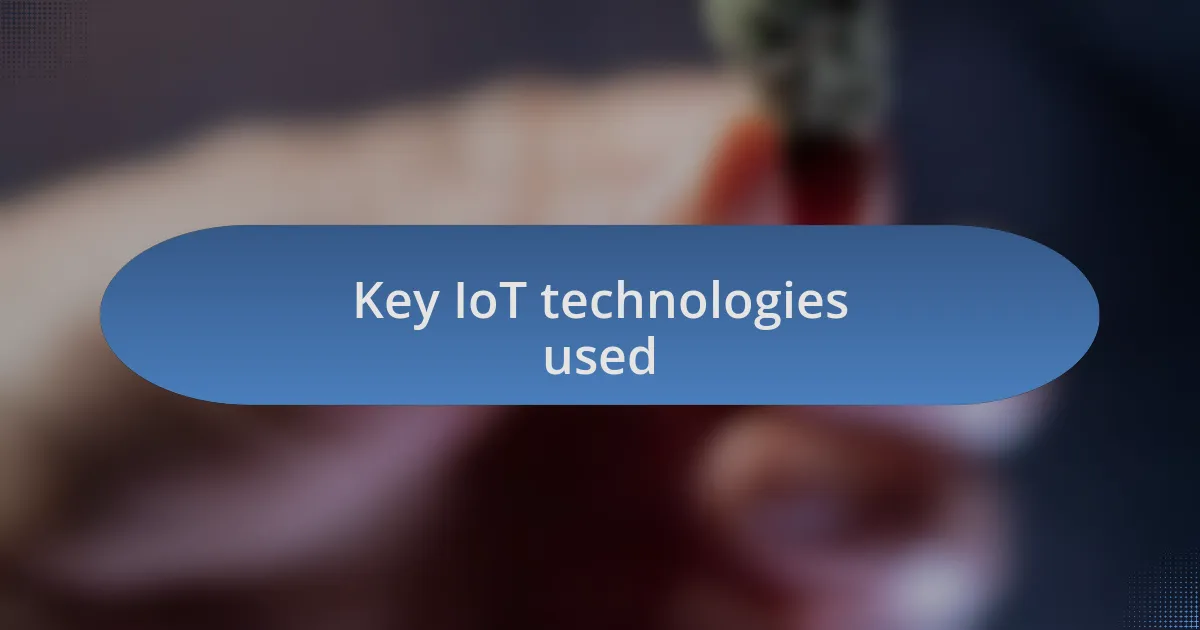
Key IoT technologies used
The heart of IoT technology in cannabis cultivation lies in sensor networks. When I first installed soil moisture sensors throughout my grow room, it felt like having a trusty companion on my side. These devices regularly transmitted data, allowing me to see exactly when to water my plants. Isn’t it comforting to know that technology can help us make those crucial decisions with just a glance at our phones?
Another important technology is the use of connected cameras for remote monitoring. I remember checking in on my grow using a live feed while on vacation. It gave me immense peace of mind, knowing I could catch any issues immediately, whether it was a broken light or an unexpected pest. This real-time visual data enhanced my ability to respond swiftly, keeping my plants healthy without sacrificing the break I so desperately needed.
Moreover, automated climate control systems play a critical role. My initial setup was a bit overwhelming with the vast array of parameters to monitor. However, once I integrated devices that communicated with each other, adjusting temperature and humidity based on real-time conditions became effortless. I often think back to those early days of guesswork—now, my plants thrive thanks to the seamless orchestration of technology harmonizing with nature. How revolutionary is that?

Steps to implement IoT
To effectively implement IoT in cannabis cultivation, the first step is to define your key objectives. I recall sitting down with a notebook, listing the specific challenges I faced and the outcomes I desired. This clarity helped prioritize which IoT technologies were crucial. What problems do you want to solve? Understanding your goals is essential in guiding your technology choices.
Once the objectives are set, the next step involves selecting compatible devices and platforms. I remember feeling overwhelmed by the multitude of options available, from sensors to software solutions. However, I found that researching community feedback and talking to other growers helped me narrow it down to the systems that integrated well with each other. Does the technology mesh with your existing setup? Taking the time to choose wisely can save you headaches down the line.
After you’ve chosen your devices, it’s time to focus on installation and configuration. During my first installation, I was filled with anticipation but also a bit of anxiety. Ensuring each sensor was correctly placed and calibrated took time, but the payoff was worth it. Once I had everything set up properly, seeing the data flow in real-time was incredibly fulfilling. Did I ever imagine I’d be farming with smart technology? Not at all, but now it feels like second nature!
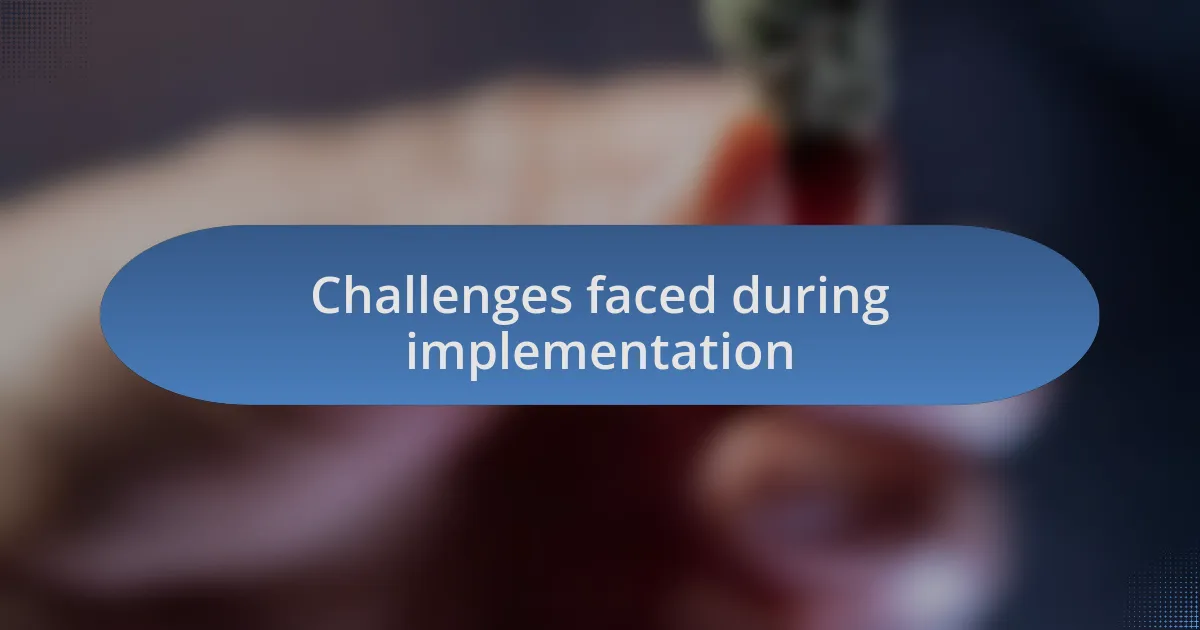
Challenges faced during implementation
Implementing IoT in cannabis cultivation does not come without its hurdles. One significant challenge I faced was ensuring network connectivity across my growing area. I envisioned seamless data transmission, but there were obstacles like dead zones where devices struggled to communicate. Have you ever felt the frustration of watching your technology fail to perform just when you need it most? Trust me, it was a stark reminder of how crucial a stable network is for real-time monitoring.
Another hurdle was the initial investment costs associated with IoT. I had to wrestle with the fear of spending significant money on technology that might not yield immediate returns. There were times I questioned whether I was making a sound decision or just diving into a tech craze. It wasn’t until I started seeing measurable improvements in plant health that my anxiety eased, proving the long-term value of those upfront costs.
Integration with existing systems posed yet another challenge. During the process, I encountered compatibility issues between new sensors and the software I had relied on for years. It felt like I was trying to fit a square peg into a round hole! Navigating through these unexpected technical difficulties was frustrating but ultimately taught me the importance of thorough research and planning before implementation. Have you ever had to troubleshoot a tech issue that seemed insurmountable at first? It’s all part of the learning curve!
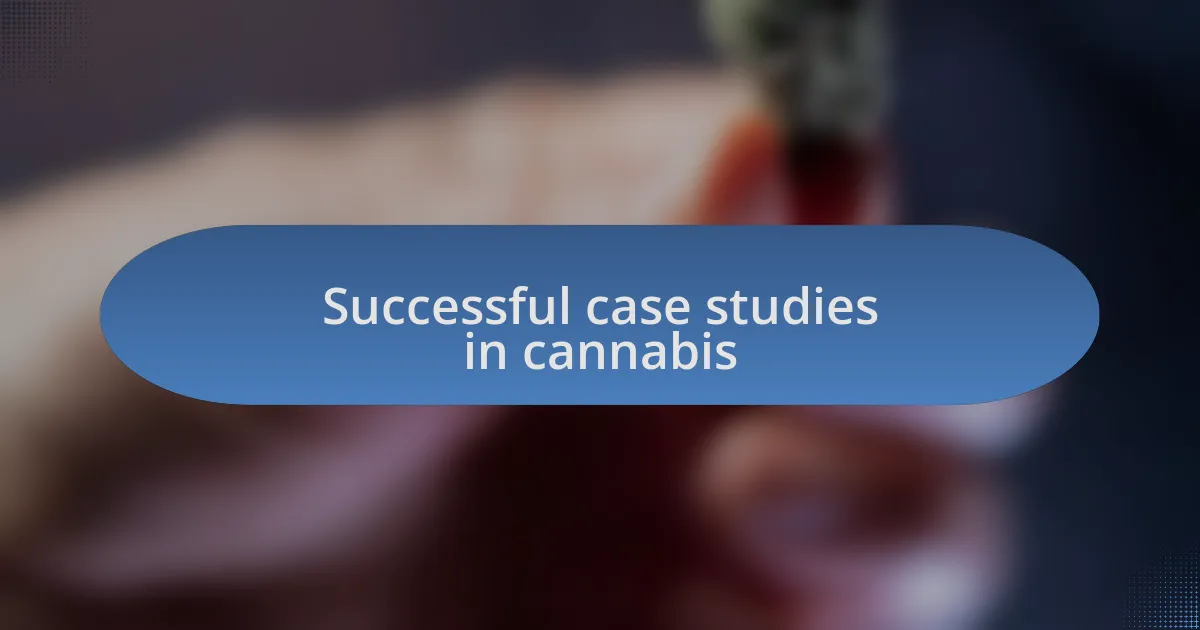
Successful case studies in cannabis
Numerous cultivators have successfully integrated IoT technology into their cannabis operations, demonstrating remarkable results. For instance, a leading Canadian grower adopted an automated irrigation system linked with soil moisture sensors. I recall discussing this case with the grower, who shared how they reduced water consumption by 30% while maintaining optimal plant health. Isn’t it fascinating how tech can transform resource management and sustainability in cultivation?
Another compelling example can be found in a California dispensary that implemented IoT-enabled air quality monitors. They observed an impressive 25% increase in their harvest yield after making adjustments based on real-time data. Can you imagine the excitement when they realized that simple tweaks could lead to more abundant and healthier crops? It truly highlights the power of leveraging technology to enhance cultivation practices.
Moreover, some farms have utilized AI-driven analytics to predict pest outbreaks before they escalate. I spoke with a cultivator who cited a 40% reduction in pesticide usage after they began using predictive algorithms. The relief in their voice was palpable—they no longer faced the overwhelming stress of guessing when pests would strike. This kind of proactive approach not only protects the plants but also promotes a healthier ecosystem. How can we ignore the potential for IoT to foster both efficiencies and sustainability in cannabis cultivation?
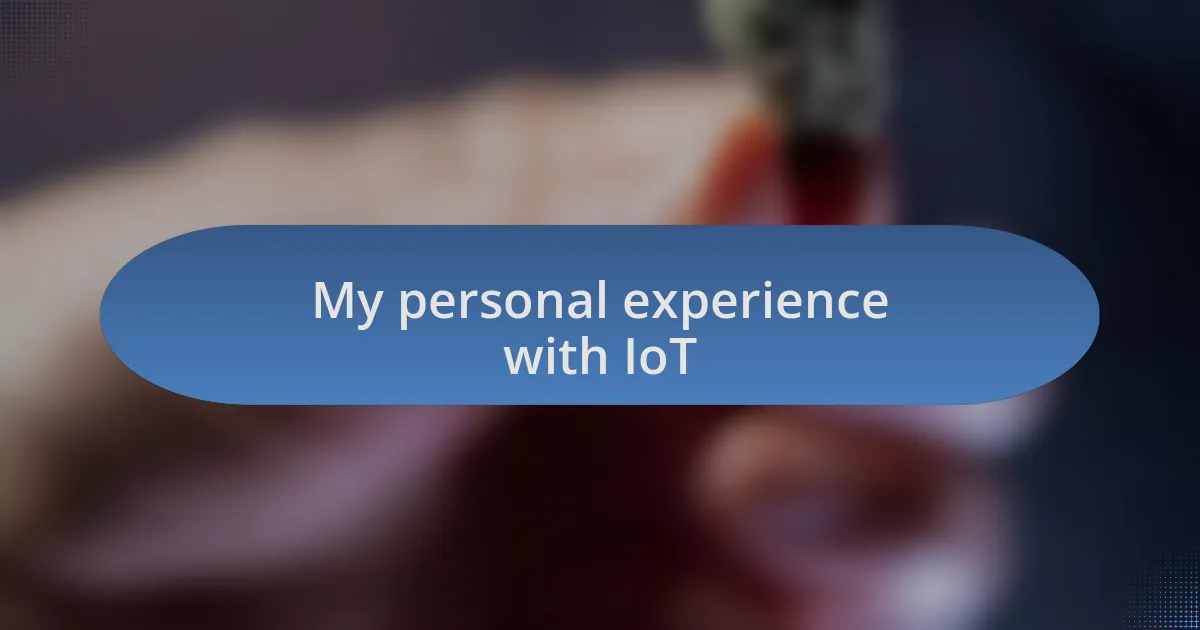
My personal experience with IoT
As I embarked on my own journey of integrating IoT into cannabis cultivation, I was initially overwhelmed by the myriad of options available. However, once I settled on implementing smart sensors for monitoring temperature and humidity, everything changed. I still vividly remember the first time I checked the app on my phone and saw the real-time data; it felt like having a personal assistant for my plants.
One specific moment stands out to me—during a heat wave, my sensor alerted me to a spike in temperature. I immediately adjusted the cooling systems, preventing potential damage to my crops. The relief I felt knowing I could respond so quickly was immense; it was like having a sixth sense tailored to the needs of my plants. Have you ever had that kind of immediate response to a potential crisis? It truly underscores how IoT can be a game-changer in cultivation.
I’ll never forget the first harvest after incorporating these technologies. The yield exceeded my expectations, and I attribute a significant part of that success to the data-driven decisions I could now make. Witnessing the thriving plants and knowing I had made informed choices gave me a sense of accomplishment. Isn’t it amazing how technology not only supports growth but also fosters a deeper connection between the cultivator and their craft?